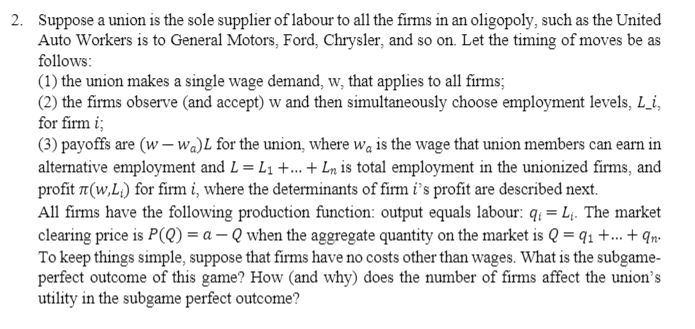
2. Suppose a union is the sole supplier of labour to all the firms in an oligopoly, such as the United Auto Workers is to General Motors, Ford, Chrysler, and so on. Let the timing of moves be as follows: (1) the union makes a single wage demand, w, that applies to all firms; (2) the firms observe (and accept) w and then simultaneously choose employment levels, Li, for firm i; (3) payoffs are (w wall for the union, where wa is the wage that union members can earn in alternative employment and L = L1 +...+ Ln is total employment in the unionized firms, and profit Te(w,L) for firm i, where the determinants of firm is profit are described next. All firms have the following production function: output equals labour: qi = Lj. The market clearing price is P(Q)= a - Q when the aggregate quantity on the market is Q = 91 +...+qno To keep things simple, suppose that firms have no costs other than wages. What is the subgame- perfect outcome of this game? How and why) does the number of firms affect the union's utility in the subgame perfect outcome? 2. Suppose a union is the sole supplier of labour to all the firms in an oligopoly, such as the United Auto Workers is to General Motors, Ford, Chrysler, and so on. Let the timing of moves be as follows: (1) the union makes a single wage demand, w, that applies to all firms; (2) the firms observe (and accept) w and then simultaneously choose employment levels, Li, for firm i; (3) payoffs are (w wall for the union, where wa is the wage that union members can earn in alternative employment and L = L1 +...+ Ln is total employment in the unionized firms, and profit Te(w,L) for firm i, where the determinants of firm is profit are described next. All firms have the following production function: output equals labour: qi = Lj. The market clearing price is P(Q)= a - Q when the aggregate quantity on the market is Q = 91 +...+qno To keep things simple, suppose that firms have no costs other than wages. What is the subgame- perfect outcome of this game? How and why) does the number of firms affect the union's utility in the subgame perfect outcome







